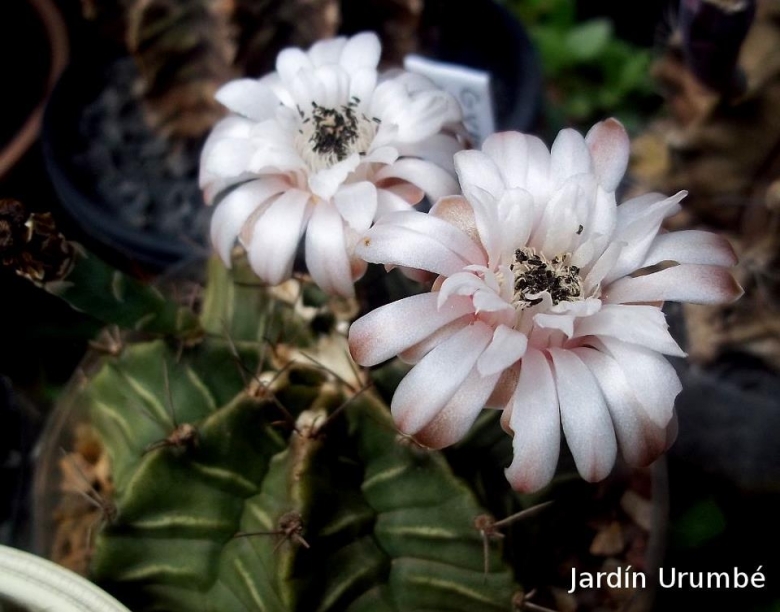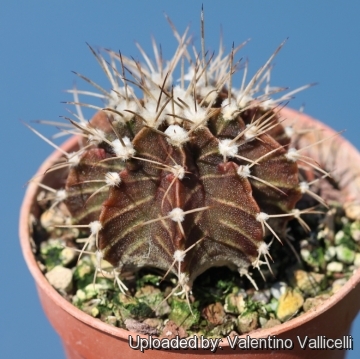
Gymnocalycium stenopleurum Photo by: Alexander Arzberger
Origin and Habitat: Gymnocalycium stenopleurumSN|11931]]SN|11931]] occurs in the Cerro León, Boquerón department of Paraguay in the in the C "Chaco seco" and possibly also in adjacent Bolivia.
Altitude range: It has been reported at elevations between 10 and 500 metres above sea level.
Habitat and Ecology: This cactus occurs in xerophilous Chacoan forest, on clayey soil. This species is relatively common but not abundant. The area where it occurs is not used for human activities. There are no known threats to this species.
Synonyms:
See all synonyms of Gymnocalycium stenopleurum
back
Accepted name in llifle Database:Gymnocalycium stenopleurum F.RitterKakteen Südamerika 1: 265 (266), figs. 1979Synonymy: 7
back
Description: Gymnocalycium stenopleurum is a small solitary cactus with with grey-green and brownish-red banded body that typically has white, fully opening flowers.
Stem: Flattened globose to globose, grey-green, to 12 cm or more high, 6-12 cm in diameter.
Ribs: 8-14, rounded.
Spines: Needle-like to awl shaped, light to dark brown, somewhat twisted.
Central spines: Usually absent.
Radial spines: 3-6, 7-40 mm long.
Flowers: White, 5-7 cm long, but also pale to dark pink.
Fruits: Grey-green, to 4 cm long and 1 cm in diameter.
Similar species: Gymnocalycium mihanovichiiSN|11929]]SN|11929]], Gymnocalycium anisitsii.
Subspecies, varieties, forms and cultivars of plants belonging to the Gymnocalycium mihanovichii/stenopleurum group
The name Gymnocalycium mihanovichii v. friedrichii was introduced by Werdermann in 1936. Pazout suggested the name G. friedrichii nom. inval. in 1964 but it has not been officially approved. In 1979 Ritter made a description of Gymnocalycium stenopleurum that sometimes can be found under the incorrect name G. mihanovichii v. stenopleurum n. n. (don't confuse it with v. stenogonum). Thus we have 3 taxa: "mihanovichii", "friedrichii" and "stenopleurum". Not taking into account their taxonomic definition they are basic points of the complex with many transitional forms between. These three taxa spread from south to north (North-Western Paraguay): The typical "mihanovichii" inhabits the very south of the area – south and south-east of province Boqueron; "stenopleurum" inhabits a limited area on the very north – in Cerro Leon region and has characteristic recognizable habitus; for "friedrichii" all the area between two mentioned points is indicated.
 Gymnocalycium friedrichii (Werderm.) Pazout: Distingushed from Gymnocalycium miahanovichii for the prevalently purplish pink, wide open flowers and well-pronounced polymorphism of spines. Besides it has tall slender ribs and roller-shaped prominent thickening around areoles.
Gymnocalycium friedrichii (Werderm.) Pazout: Distingushed from Gymnocalycium miahanovichii for the prevalently purplish pink, wide open flowers and well-pronounced polymorphism of spines. Besides it has tall slender ribs and roller-shaped prominent thickening around areoles. Gymnocalycium friedrichii f. cristatum hort.: Crested form with nice stems reddish brown to dark grape coloured.
Gymnocalycium friedrichii f. cristatum hort.: Crested form with nice stems reddish brown to dark grape coloured. Gymnocalycium friedrichii var. moserianum Pazout ex Moser: has brown bodies 2 times larger than G. friedrichii, with sharp ribs striped with white, and only 3 weak spines. Flowers are pale pink and open up entirely. Distribution: Yrebdaque, Boquerón, Paraguay.
Gymnocalycium friedrichii var. moserianum Pazout ex Moser: has brown bodies 2 times larger than G. friedrichii, with sharp ribs striped with white, and only 3 weak spines. Flowers are pale pink and open up entirely. Distribution: Yrebdaque, Boquerón, Paraguay. Gymnocalycium mihanovichii (Frič ex Gürke) Britton & Rose: It has wider, lower ribs, in juvenile plants divided into separate chins, in maturity every rib have flat surface and a pleat above each areole. But the essential thing is its pale or brownish-yellow, not fully opening flower.
Gymnocalycium mihanovichii (Frič ex Gürke) Britton & Rose: It has wider, lower ribs, in juvenile plants divided into separate chins, in maturity every rib have flat surface and a pleat above each areole. But the essential thing is its pale or brownish-yellow, not fully opening flower. Gymnocalycium mihanovichii var. filadelfiense Backeb.
Gymnocalycium mihanovichii var. filadelfiense Backeb. Gymnocalycium mihanovichii var. stenogonum Frič & Pazout: has larger stem (up to 15 cm in diameter), smooth fresh green to bronze in full sun. The greenish flowers are also larger. Distribution: Toro Alarachii, southern Chaco, Argentina.
Gymnocalycium mihanovichii var. stenogonum Frič & Pazout: has larger stem (up to 15 cm in diameter), smooth fresh green to bronze in full sun. The greenish flowers are also larger. Distribution: Toro Alarachii, southern Chaco, Argentina. Gymnocalycium mihanovichii cv. Hibotan hort.: chlorophylles mutants, characterized by more or less red coloured bodies.
Gymnocalycium mihanovichii cv. Hibotan hort.: chlorophylles mutants, characterized by more or less red coloured bodies. Gymnocalycium mihanovichii cv. Hibotan f. cristata hort.: this is the crested form of the chlorophyll-less cv. Hibotan characterized by more or less red coloured bodies.
Gymnocalycium mihanovichii cv. Hibotan f. cristata hort.: this is the crested form of the chlorophyll-less cv. Hibotan characterized by more or less red coloured bodies. Gymnocalycium mihanovichii cv. Nishikii hort.: variegated cultivars only partially de-coloured.
Gymnocalycium mihanovichii cv. Nishikii hort.: variegated cultivars only partially de-coloured. Gymnocalycium stenopleurum F.Ritter: Distingushed from Gymnocalycium miahanovichii for the white, fully opening flowers. Distribution: Cerro León, Boquerón department of Paraguay.
Gymnocalycium stenopleurum F.Ritter: Distingushed from Gymnocalycium miahanovichii for the white, fully opening flowers. Distribution: Cerro León, Boquerón department of Paraguay.
Bibliography: Major references and further lectures
1) Edward Anderson “The Cactus family” Timber Press, Incorporated, 2001
2) David R Hunt; Nigel P Taylor; Graham Charles; International Cactaceae Systematics Group. "The New Cactus Lexicon" dh books, 2006
3) Pin, A. & Oakley, L. 2013. “Gymnocalycium stenopleurum”. The IUCN Red List of Threatened Species. Version 2014.3. <www.iucnredlist.org>. Downloaded on 29 April 2015.
4) James Cullen, Sabina G. Knees, H. Suzanne Cubey "The European Garden Flora Flowering Plants: A Manual for the Identification of Plants Cultivated in Europe, Both Out-of-Doors and Under Glass" Cambridge University Press, 11/Aug/2011
5) Dmitriy Rogatskin “Controversial point” Cultivar e-magazin ISSUE 3 (25): 4 <http://www.lapshin.org/cultivar/N25/index-e.htm>
 Gymnocalycium stenopleurum Photo by: Valentino Vallicelli
Gymnocalycium stenopleurum Photo by: Valentino VallicelliSend a photo of this plant.The gallery now contains thousands of pictures, however it is possible to do even more. We are, of course, seeking photos of species not yet shown in the gallery but not only that, we are also looking for better pictures than those already present.
Read More... Cultivation and Propagation: Gymnocalycium stenopleurumSN|11931]]SN|11931]] is a summer grower species that is easy to cultivate.
Growth rate: It is a relatively rapidly growing and easily flowering species.
Soils: It likes very porous standard cactus mix soil. Prefer a low pH compost, avoid substrata rich in limestone; otherwise growth will stop altogether.
Repotting: This plant needs plenty of space for its roots, repotting should be done every other year or when the it has outgrown its pot. Use pot with good drainage.
Watering: Needs moderate to copious waterings in summer, but do not overwater (Rot prone), keep dry in winter at a minimum temperature of 0°C.
Fertilization: Feed with a high potassium fertilizer in summer.
Hardiness: Quite frost resistant if kept dry -10° C (Temperature Zone USDA 8-10), but for safe cultivation it is best to avoid freezing temperatures.
Exposition: The plant tolerates extremely bright situations but enjoys filtered sunlight or afternoon shade, inside it needs bright light, and some direct sun. Tends to bronze in strong light, which encourages flowering and heavy spine production, but is likely to suffer from sun scorch or stunted growth if over exposed to direct sunlight during the hottest part of the day in summer.
Uses: It is an excellent plant for container growing. It always looks good and stays small. It look fine in a cold greenhouse and frame or outdoor in a rockery.
Pests & diseases: It may be attractive to a variety of insects, but plants in good condition should be nearly pest-free, particularly if they are grown in a mineral potting-mix, with good exposure and ventilation. Nonetheless, there are several pests to watch for:
- Red spiders: Red spiders may be effectively rubbed up by watering the plants from above.
- Mealy bugs: Mealy bugs occasionally develop aerial into the new growth among the wool with disfiguring results, but the worst types develop underground on the roots and are invisible except by their effects.
- Scales: Scales are rarely a problem.
- Rot: This species is particularly easy and accommodating, seldom suffer of cryptogamic diseases. Rot it is only a minor problem with gymnocalyciums if the plants are watered and “aired” correctly. If they are not, fungicides won't help all that much.
Propagation: Seeds (seldom produces offsets). Seeds germinate in 7-14 days at 21-27° C in spring, remove gradually the glass cover as soon the plants will be well rooted (ca 1-2 weeks) and keep ventilated, no full sun for young plants!











